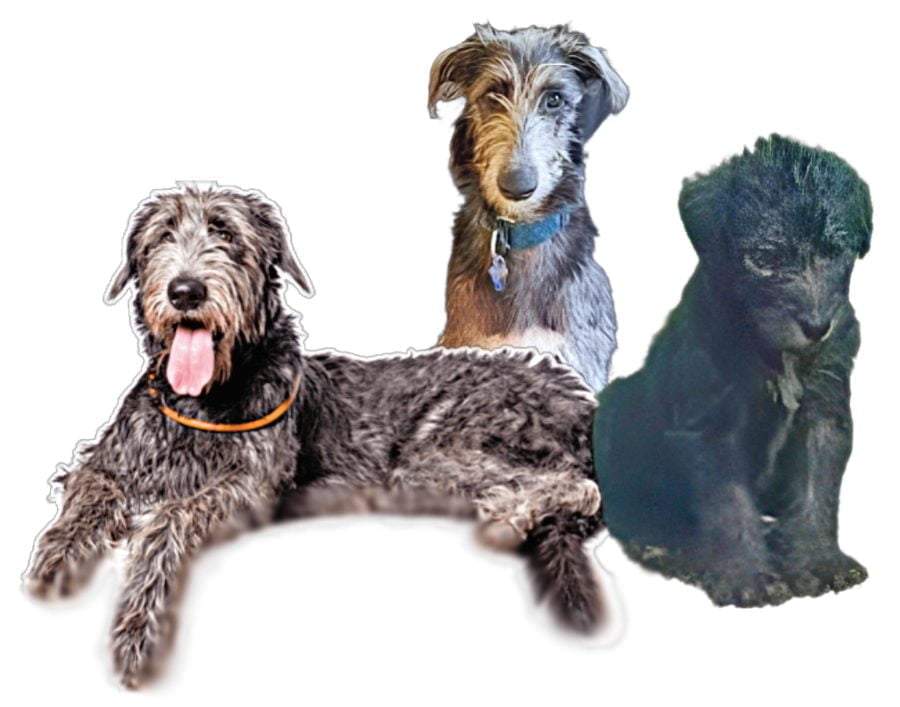The Scottish Deerhound or “The Royal Dog of Scotland”, is a large breed of hound, once used primarily for hunting deer. Although they were bred for hunting, they make excellent companion dogs and are especially good with children. If you are looking for a calm, gentle, and loving dog to add to your family, the Scottish Deerhound is the breed for you. They are gentle giants who will adore your children and provide them with hours of entertainment and companionship.
History
The Scottish Deerhound (sometimes known as Highland Deerhound, Scotch Greyhound, Rough Greyhound or Blue Greyhound) is a large breed of hound, once bred to hunt red deer by sight in the Scottish Highlands. However, the breed has been significantly declining in numbers since the end of the 19th century. Though the Scottish Deerhound is not currently recognized by the American Kennel Club, it is recognized by the United Kennel Club and by the Fédération Cynologique Internationale.

Size
The Scottish Deerhound is a large, muscular breed with a short, dense coat. The coat is Brindle, Fawn, Red Fawn, Blue, Grey or Yellow in color. The breed has a long head and neck, and a deep chest. They are one of the tallest breeds of dogs. They typically stand between 28 and 32 inches tall at the shoulder. And, they weigh between 85 and 110 pounds. When it comes to lifespan, Scottish Deerhounds typically live between 8 and 11 years.
Personality
Despite their gentle nature, Scottish Deerhounds are still dogs and they have distinct personalities that set them apart from other breeds. They are loyal, friendly, and gentle. They are also independent and stubborn, which can make them challenging to train. However, their loyalty and affection make them great family dogs. They are also fairly active and need plenty of exercise, so they are not a good fit for families who are not able to provide them with adequate exercise.
Food
As a large and active breed, the Scottish Greyhound dog requires a diet that is high in protein and fat. This breed is also known to be susceptible to bloating, so it is important to choose a food that is easy to digest. Some good food options for this dog include: meat, carcasses, raw bones, organs and vegetables. All of these food options should be sourced from reputable sources and fed in moderation. Too much of any one thing can cause problems for the Scottish Deerhound dog, so it is important to create a well-rounded and balanced diet.
Grooming
Scottish Deerhounds are known for their thick coat of fur, which requires regular grooming. First, you will need to brush your dog’s fur on a daily basis. This will help to remove any dirt or debris that may be trapped in their fur. You should also use a de-tangling spray or conditioner to help prevent mats and tangles from forming. Next, you will need to trim your dog’s nails on a monthly basis. If you do not keep up with this, their nails can become overgrown and uncomfortable. You can either do this yourself at home or take them to a professional groomer.

Training
Scottish Deerhounds are intelligent and eager to please, making them fairly easy to train. However, they can be stubborn at times and need a patient, consistent trainer. Because they are so intelligent, they will quickly catch on to any inconsistency in your commands or training methods, so it’s important to be as consistent as possible. Scottish deerhounds are very sensitive dogs, so it’s important to be firm but gentle when training them. They will quickly become discouraged if they feel they are being yelled at or scolded, so it’s important to find a balance between firmness and gentleness. Whenever your dog does something you want them to do, whether it’s following a command or simply sitting quietly, be sure to praise them enthusiastically.
Health
The Scottish Deerhound is a large and powerful hound, bred for centuries to hunt deer in the wilds of Scotland. Today, they make loyal and loving companions. But like all dogs, they are susceptible to certain health problems like allergies, joint issues, and digestive problems. That’s why it’s important to find a good health insurance plan for your dog. There are a few things to keep in mind when shopping for health insurance for your Scottish Deerhound. First, make sure you choose a plan that covers routine checkups and vaccinations. Also, make sure you choose a plan with ample coverage limits, so you can rest easy knowing your dog is covered in the event of an accident or illness.
Bottom Line
The Scottish Deerhound is an old breed of hound, once known as the Scotch Greyhound or the Rough Greyhound. They were used to hunt red deer in the forest of Ettrick, located in the Scottish Borders. The breed was nearly extinct by the end of the 19th century, but was saved by a few dedicated breeders. Today, Deerhounds are still relatively rare, but are slowly gaining in popularity.
These dogs are fairly low-maintenance, and while they do need daily exercise, they’re relatively calm indoors. Deerhounds are also good with children and other pets. So, if you’re looking for a large, loyal, and gentle companion, a Scottish Deerhound may be a good choice.








